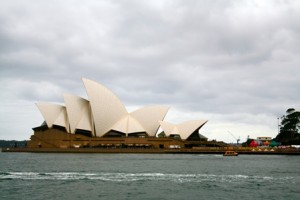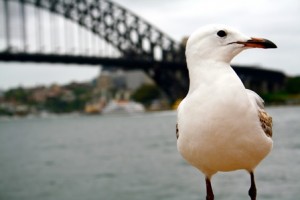
Submitted by Tyler Coty on the 2014 winter session study abroad program in Australia and Hawaii sponsored by the School of Nursing…
The most frightening plane landing of my life equipped with severe turbulence, misty skies and blustering winds set the tone for an interesting ten days in Sydney, Australia — named the “most beautiful city in the world” by several travel organizations. This tumultuous beginning has led to one of the most enlightening and fruitful weeks of my life.
On our first day in this beautiful, clean city, we ventured down to Darling Harbour, just ten minutes from our hotel. The sparkling blue water reminded me of the Mediterranean along with the cool breeze sweeping across the yacht-lined bay. Red flags draped the dockside to commemorate the celebration of Australia Day, a historical mark for the discovery of this diverse continent. We took a city bus across town to Sydney Harbour and the Circular Quay and at first sight, I could see the glistening cream ceramic covering the roof of its namesake Opera House, just as beautiful as I’ve seen in pictures. 
Towering skyscrapers lined the harbour with mirrored windows reflecting the cerulean bay. Along the edge of the water set in sandstone are the Rocks, a historical area of Sydney where settlers first arrived, most of whom were English convicts banished from the British Isles for petty crimes. Here we learned about the history of Australian nursing. Interestingly enough, the earliest nurses here were convicts themselves, operating freely at the lowest point of the Rocks, where sewage running down from higher areas created vegetating sickness and bacterial disease. It wasn’t until the arrival of Florence Nightingale’s chosen nurse specialist Lucy Osbourn that nursing strayed from chaotic maltreatment to organized aseptic care.
Following this tour of the historical areas of Sydney, we visited the Sydney Hospital, a building of rich sandstone constructed to service the convicts living on the Rocks. Traditional nursing was practiced here following Osbourn’s arrival, and the hospital today has several new developments including the clinical services building containing an emergency department, a Nightingale wing for opthalmic research and a specialized opthamology department for the most diverse array of eye injuries presenting in New South Wales. It was interesting to see the development of nursing across Australian history and the role these nurses played in advancing the Australian healthcare delivery system. We also visited the Florence Nightingale Museum, which featured a display of preserved morbid anatomy; this covered hundreds of pathologies the human body can experience from melanoma with metastasis to the human brain to a parasitic infection of the iliac bone marrow.
It will be interesting to see what this week has to offer in this undoubtedly flourishing city of dynamic cultural backgrounds. I don’t want this journey to end, but its rapidly approaching. Until next time…

